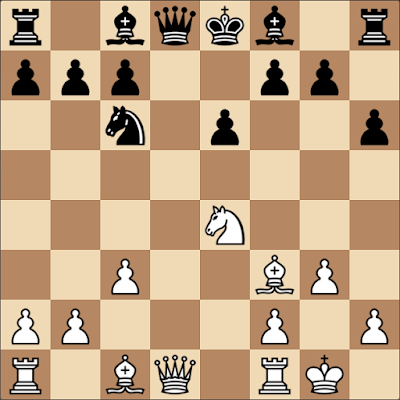Game Analysis #19: Unclear Positions
When I played this game, I didn’t know anything about openings, let alone that the one I did was called the Hungarian Opening. It’s not one of the more popular Queen’s pawn openings but I was probably just playing what I thought would get me into the least amount of trouble.
I didn’t get too much out of the opening but Black was solid and there weren’t any big weaknesses that White could target. It might have been a bit weird when White pushed e4 without preparing it. Technically, that allowed me to be a pawn up in the opening which I could have taken advantage but I just didn’t have enough experience to know how to do just that.
After move 10, Black has a slight advantage. Black could have exchanged queens and developed pieces in order to have a solid game. His structure is intact and he has an extra pawn which would be great in an endgame if Black is able to keep that slight advantage. However, that was not played and the passive Bd7 gave White a slim lead although it’s almost negligible.
I have identified three critical points for this game and we will discuss each in turn. We might give a few suggestions for alternative moves or better moves that could have been done in the position.
13… Rc8
Things started to go downhill for Black with Rc8, another passive move that doesn’t really help with anything. I’m not really sure what I was planning to do with the rook here. There are several moves that are a lot better than Rc8, primarily Nf3+ would have given Black a little bit of an edge. Other possible moves are Be7 and Bc8.I’m not sure about the latter but I think the computer wants to go into the endgame and move the pieces to better squares. The light-square bishop has no prospects on the a4-e8 diagonal and it is probably planning on maneuvering it to the b7-square in order to fight for the a8-h1 diagonal.
15. Bc1
This move gives Black a slight advantage. White could have opted for a more active way of defending his bishop like with Qe2 or Qb3 which would also connect the rooks. Furthermore, Black doesn’t have any incentive to take on White’s dark-square bishop since at the moment it isn’t that active.Currently, most of the pieces are concentrated on the queenside. Black would want the c-file to open up for his rook but that’s easier said than done since White’s light-square bishop is hitting the b-pawn. Before he blasts the position open on that side, he must first prepare for it. Moreover, if Black were to lose one of his queenside pawns, White would have a strong passed pawn and that would be the focus of his attacks.
Once that happens, Black would not have any time to defend as most of his pieces are currently not that active either, and his king still needs to find safety. So we would need a little more maneuvering before anything big happens.
It doesn’t take long before things start to favor White. However, when pieces are exchanged and the position becomes more simplified, it appears that White doesn’t have that big of a lead.
21. Be3
The last critical point is Be3 since it allows Black to go into the endgame and hope that he can have good drawing chances even after losing one of his queenside pawns. The imbalance of the pawn structures would be the highlight of the endgame, however, it won’t be too decisive if both sides play accurately.Unfortunately for me, I blundered and played b6 right after this and that was immediately game over as it is mate in two with Bc6+ and Qd7# coming next.
Small advantages
While I was looking through this game, I noticed that there weren’t any glaring blunders except that last one. You wouldn’t know right off the bat who has the advantage since most of the time, the evaluation was close to equal with slight leaning toward White and Black at certain points of the game.We also see from the position that there aren’t a lot of holes to exploit in either side so this is supposedly a maneuvering kind of game where you try to improve the position of your pieces slowly but surely until such point that one side makes a mistake that you can capitalize on and from which you gain momentum.



Comments
Post a Comment